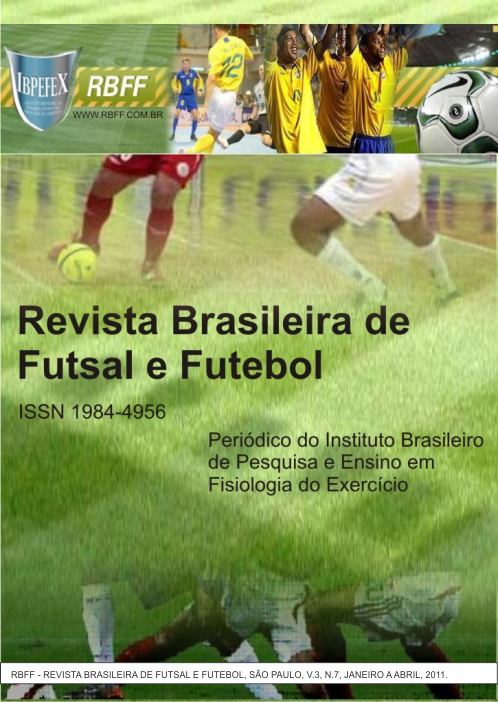Quantitative analysis of yellow and red cards during the course of the League of Brazilian Professional Soccer; Series A of 2008
Abstract
Has developed this study aiming to quantify and analyze in terms of time a card (yellow and red), followed by football referees during the games of the Brazilian championship of professional football in 2008. Football is characterized as a physical activity in direct contact with the enemy in the field of play that requires efforts of high intensity and great physical wear. Over the years, the average distances covered by players during a soccer game rose considerably, with it, the football referees in addition to good technical knowledge, they must be good physical condition to monitor the development of the game. These new demands have brought sports to the presence of elements and neutral bodies and agencies to promote, international arbitrators established by the performance in terms of its function and control of violence.The flexible character and interpretation of the rules in their application generates discord on the issue. Data collection was conducted through the official summaries of games where the cards are reported and that time were applied to the athletes that are filed in the Brazilian Football Confederation (CBF).
References
-Borsari, J.R. A evolução do futebol: O combate à violência e o resgate da ética e do fair play. São Paulo. EPU. 2002.
-Brunetti, A.P.; Adolfo, J.; Brum, P.P.; Sampaio, V.M.; Dantas, E.H.M.; Santos, M.A.A. Influência da ordem da sessão do treinamento concorrente sobre a resposta aguda do lactato sangüíneo, freqüência cardíaca e do consumo de oxigênio. Fitness & Performance Journal. Rio de Janeiro. Vol. 7. Núm. 5. 2008. p. 326-331.
-Confederação Brasileira de Futebol. Regras Oficias de Futebol. 2ª edição. Rio de Janeiro. Sprint. 2004.
-Frisselli, A.; Mantovani, M. Futebol: Teoria e Prática. São Paulo. Phorte. 1999.
-Weineck, J. Futebol Total: O treinamento físico no futebol. São Paulo. Phorte. 2000.
-Matos, J.A.B.; Aidar, F.J.; Mendes, R.R.; Lômeu, L.M.; Santos, C.A.; Pains, R.; Silva, A.J.; Reis, V.M. Capacidade de aceleração de jogadores de futebol. Fitness & Performance Journal. Rio de Janeiro. Vol. 7. Núm. 4. 2008. p. 224-228.
-Melo, R.S. Futebol: Da Iniciação ao Treinamento. Rio de Janeiro. Sprint. 2001.
-Moraes, M. Futebol é Arte. Rio de Janeiro. Mis Editorial. 2002.
-Moreira, S.B. A evolução de fatores individuais de desempenho na elite do futebol mundial, entre 1970 e 1998. Fitness & Performance Journal. Rio de Janeiro. Vol. 7. Núm. 2. 2008, p. 107-111.
-Perry, V. Código Brasileiro Disciplinar de Futebol e Legislação Complementar Ordenamento e Comentários. 2ª edição. Rio de Janeiro. Lúmen júris. 2000.
-Santos, A.C.; Rodrigues, J.J.F. Análise da instrução do treinador de futebol. Comparação entre a preleção de preparação e a competição. Fitness e Performance Journal. Rio de Janeiro. Vol. 7. Núm. 2. 2008. p. 112-122.
-Silva, A.I. Bases Científicas e Metodológicas para o Treinamento do Árbitro de Futebol. Curitiba. 2005.
-Unzelte, C. O livro de Ouro do Futebol. 3ª edição. São Paulo. Ediouro. 2002.
Authors who publish in this journal agree to the following terms:
- Authors retain the copyright and grant the journal the right of first publication, with work simultaneously licensed under the Creative Commons Attribution License BY-NC which allows the sharing of the work with acknowledgment of the authorship of the work and initial publication in this journal.
- Authors are authorized to enter into additional contracts separately for non-exclusive distribution of the version of the work published in this journal (eg, publishing in institutional repository or book chapter), with acknowledgment of authorship and initial publication in this journal.
- Authors are allowed and encouraged to post and distribute their work online (eg, in institutional repositories or on their personal page) at any point before or during the editorial process, as this can bring about productive change as well as increase impact and impact. citation of published work (See The Effect of Free Access).





